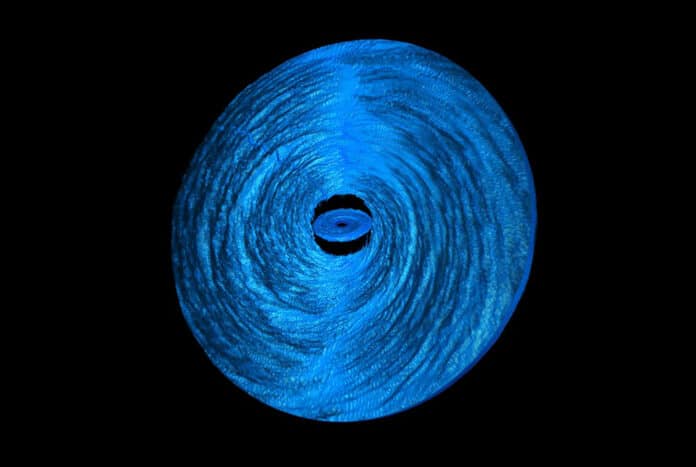According to the previous hypothesis, black holes eat slowly. But, a new study by Northwestern University contradicts it, suggesting that black holes scarf food much faster than expected. The study changes astrophysicist’s understanding of the eating habits of supermassive black holes.
Scientists created new high-resolution 3D simulations of accretion disks. It is one of the highest-resolution simulations of accretion disks to date.
The simulations suggest that the furious whirlpool of gas (or accretion disk) that surrounds and feeds spinning black holes is eventually torn apart by the space-time distortions caused by the black hole’s rotation. Due to this, the disk splits into an inner and an outer subdisk. Black holes first consume the inner ring. The eating process then resumes when debris from the outer sub-disk spills inward to fill the space left behind by the completely devoured inner ring.
In contrast to the hundreds of years that prior studies suggested, one cycle of the continuously repeating eat-refill-eat process only lasts a few months.
Northwestern‘s Nick Kaaz, who led the study, said, “Classical accretion disk theory predicts that the disk evolves slowly. But some quasars — which result from black holes eating gas from their accretion disks — appear to change drastically over time scales of months to years. This variation is so drastic. It looks like the inner part of the disk — where most of the light comes from — gets destroyed and then replenished. Classical accretion disk theory cannot explain this drastic variation. But the phenomena we see in our simulations potentially could explain this. The quick brightening and dimming are consistent with the inner regions of the disk being destroyed.”
Previous assumptions:
In the past, scientists assumed that accretion disks are often well-organized. These models depict gas and particles revolving in the same plane as the black hole and rotating in the same direction as the black hole. Next, gas atoms progressively spiral toward the black hole throughout hundreds to thousands of years to feed it.
Kaaz said, “For decades, people made a very big assumption that accretion disks were aligned with the black hole’s rotation. But the gas that feeds these black holes doesn’t necessarily know how the black hole is rotating, so why would they automatically be aligned? Changing the alignment drastically changes the picture.”
Contrary to earlier theories, the new simulation indicates that regions surrounding the black hole are significantly messier and more turbulent.
Scientists used Summit- one of the world’s largest supercomputers at Oak Ridge National Laboratory- to carry out a 3D general relativistic magnetohydrodynamics (GRMHD) simulation of a thin, tilted accretion disk. The new model includes gas dynamics, magnetic fields, and general relativity to assemble a complete picture.
The rotation of a black hole drags surrounding space like a giant carousel and forces it to rotate as well. This phenomenon is known as frame-dragging, which creates a powerful effect close to the black hole that becomes weaker farther away.
Frame dragging causes the entire disk to sway like a gyroscope. However, the inner disk is more inclined to wobble than the outer portions. Due to this imbalance of forces, the entire disk warps, resulting in the collision of gas from various regions of the disk. Bright shocks produced by the collisions violently push material toward the black hole.
The innermost part of the accretion disk continues to wobble faster and faster until it separates from the rest of the disk as the warping worsens. The new models then predict that the subtasks begin evolving independently. The subtasks separately wobble at various speeds and angles like the wheels in a gyroscope rather than moving together smoothly like a flat plate enclosing the black hole.
The new simulation suggests that the feeding frenzy begins in the tearing region, where the inner and outer sub-disks disconnect. Friction works to keep the disk together, but the black hole’s space-time-twisting desires to rip it apart.
Kaaz said, “There is competition between the rotation of the black hole and the friction and pressure inside the disk. The tearing region is where the black hole wins. The inner and outer disks collide with each other. The outer disk shaves off layers of the inner disk, pushing it inwards.”
The subtasks now intersect at various angles. Material is poured onto the inner disk from the outer disk. This additional mass pushes The internal disk toward the black hole, where it is engulfed. The gas in the now-empty inner region is then refilled by the black hole’s gravity, which draws gas from the outer region toward it.
Simulation and Quasar:
Kaaz said these fast cycles of eat-refill-eat potentially explain so-called “changing-look” quasars. Quasars are extremely luminous objects emitting 1,000 times more energy than the Milky Way’s 200 billion to 400 billion stars. Changing-look quasars are even more extreme. They appear to turn on and off over the duration of months — a tiny amount of time for a typical quasar.
“The inner region of an accretion disk, where most of the brightness comes from, can disappear quickly over months. We see it go away entirely. The system stops being bright. Then, it brightens again, and the process repeats. Conventional theory doesn’t have any way to explain why it disappears in the first place, and it doesn’t explain how it refills so quickly.”
In addition to possibly explaining quasars, the new simulations may also provide new insight into the mystifying properties of black holes.
Kaaz said, “How gas gets to a black hole to feed it is the central question in accretion-disk physics. Knowing how that happens will tell you how long the disk lasts, how bright it is, and what the light should look like when we observe it with telescopes.”
Journal Reference:
- Nicholas Kaaz, Matthew T. P. Liska, Jonatan Jacquemin-Ide et al. Nozzle Shocks, Disk Tearing, and Streamers Drive Rapid Accretion in 3D GRMHD Simulations of Warped Thin Disks. The Astrophysical Journal. DOI 10.3847/1538-4357/ace051
